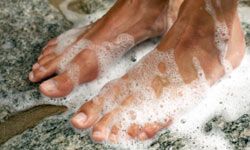We've all been there. You and a co-worker exit bathroom stalls at the same time. You -- ever diligent -- wash your hands. Your co-worker, however, smoothes his hair and walks out. He and others like him are the reason why you don't sample candy from the communal jar at the reception desk.
In an observational study in 2007, researchers saw only 77 percent of people wash their hands after using public restrooms. In another survey, only 34 percent of people reported they always washed their hands after coughing or sneezing [source: American Society for Microbiology].
Advertisement
You might be wondering why it's such a big deal, but the truth is that hand washing is one of the best ways to prevent the spread of infection and illness. Not only does it keep germs from affecting you, but it stops any bacteria from getting passed to others and causing illnesses ranging from the common cold to the far more serious -- and sometimes fatal -- Escherichia coli and salmonella.
However, even people who understand the importance of washing theirs hands might not use a technique that's actually effective. Hand washing might seem as simple as rubbing your hands together under the stream of a faucet, but there are several elements to consider, including the how long you should spend washing, how often you should do it, what temperature water you should use and what to do once you're finished.
When you wash your hands, you should have a good idea about safe water temperatures and proper washing techniques. You should also know the best way to dry your hands to ensure you don't re-contaminate yourself after washing. But up next, you'll find out the best ways to prepare for hand washing.
Advertisement


